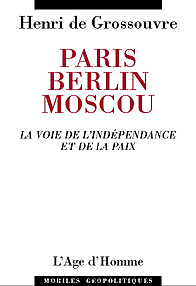"EURASIA"
"A CALL FOR COOPERATIVE RESEARCH AND ACTION"
Come Carpentier de Gourdon, August 2003
By far the largest percentage of humankind dwells on the Eurasian landmass (some 80%) where the major living civilizations and religions have originated. Not surprisingly, that "bi-continent" also accounts for the greatest and most dynamic economic activity and wealth even though it includes areas of extreme poverty.
In the current geo-political environment it is becoming both realistic and desirable to look at this massive island,(H. Mackinder's "world island) spreading from Ireland to Japan and from Norway to Sri Lanka as an economic and cultural whole, whether from a historical viewpoint or with regard to contemporary logistical and strategic considerations, and this for three major reasons:
1-There is evidence of a common original Eurasian culture which stood at the source of or decisively influenced most of the leading civilizations of this vast area and of the other continents.
2-Since a millenium at least, five major geographically and historically interlocking and overlapping political and cultural entities have shaped decisely the map of Eurasia, to wit from East to West:
a-The Chinese area of influence
b-The Indo-Iranian-SE Asian 'sphere' extending from ancient Persia to the Indochinese peninsula and the Malay archipielago
c-The Russian-Slavic perimeter
d-The Semito-Arabic area of West Asia
e-The Western-Central European commonwealth which is now regaining a certain degree of unity in the framework of the European Union.
3-The industrial, commercial and defence-related contacts between those five regions are intensifying as part of the process of globalization. Land-based corridors (the old Silk Road, the trans-siberian rail-route connecting Korea to Poland, the North-South trails from China and Central Asia to India, the Mekong-Basin highway, the N-S link between the Baltic and Black seas and the Persian Gulf across Russia and Iran etc) are being reopened and turned into vectors for all vehicles of communication and commerce.
At the very least, it is necessary to seek to prevent through multi-lateral consultations and colllaboration the outbreak of wars - threatening to escalate into conflicts fought with weapons of mass destruction - between the strategically and economically important States of Eurasia, many of which have a tradition of mutual hostility (India and Pakistan, the Koreas, China and Taiwan, Iran and its Arab neighbours etc...). Eurasian States could also lessen, through their mutual cooperation, the possibility of terrorist attacks or aggressive takeover attempts by other powers,both from within the continent and from overseas.
Evidently, the sheer size and the complexity of the Eurasian map dictate that, in the interest of efficiency, a few leading States take the lead and provide the essential conditions for the progressive cooperative integration of the continent. These States are, from West to East, the major continental EU countries, especially France and Germany, Russia as the bridge and pivot between East and West, North and South, India and Iran to the South and China to the Orient. If as some present achievement and projects indicate, those six countries can achieve meaningful cultural, economic, political and strategic cooperation, there is every reason to believe that the many other Nations of Eurasia would gradually join this commonwealth whose greater heritage they share in more than one way.
Côme Carpentier de Gourdon
August 2003

